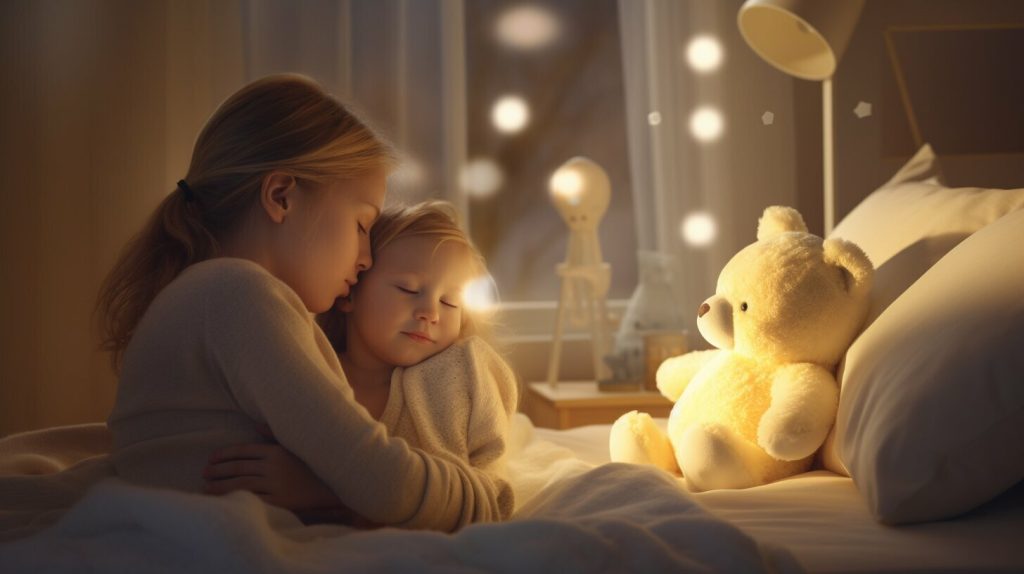Seeing your child struggle with anxiety can be heartbreaking as a parent, especially when it affects their sleep.
Anxiety in children is not uncommon, but knowing how to help them get the rest they need can be challenging.
Fortunately, several effective strategies and tips can significantly promote better sleep for anxious kids.
Some sleep strategies for anxious kids involve creating a calming bedtime routine, promoting a calm sleep environment, using relaxation techniques, and incorporating natural remedies and sleep aids.
Here, I will explore these approaches in more detail, providing practical tips and advice on how to help an anxious child sleep.
Some Important Points To Consider:
- Parents can help their anxious children sleep better by implementing a structured bedtime routine.
- A soothing sleep environment can promote relaxation and security in an anxious child.
- Relaxation techniques and natural remedies can effectively reduce anxiety and improve sleep.
- It’s essential to seek professional help if anxiety and sleep problems persist despite your efforts.

Understanding Anxiety in Children
As a Mum, I understand that anxiety is a common issue among children, and it can significantly impact their sleep patterns.
Child anxiety can manifest in various ways, such as excessive worry, fear, or avoidance of certain situations.
In some cases, anxiety can cause physical symptoms like headaches or stomach aches, making it difficult for children to fall and stay asleep.
It’s essential to recognise the signs and symptoms of anxiety in children so that you can take appropriate steps to help them.
For example, children with separation anxiety may have difficulty sleeping alone in their bedrooms, while those with social anxiety may feel anxious about attending social events.
By identifying the specific triggers of your child’s anxiety, you can tailor your approach to meet their unique needs.
There are a variety of factors that can contribute to anxiety in children. These may include genetic predisposition, environmental factors, or stressful life events such as the death of a loved one or a family move.
It’s important to remember that anxiety is a treatable condition, and you can use many effective strategies to help your child manage their symptoms and sleep better.

Creating a Calming Bedtime Routine
As I mentioned earlier, a structured and calming bedtime routine is crucial for anxious children.
Without a consistent and soothing routine, children with anxiety struggle to relax, making it difficult to fall asleep.
Here are some bedtime routine tips that can help promote a calm and restful sleep:
- Start the bedtime routine at the same time every night
- Include calming activities, such as reading a book or listening to soft music
- Avoid stimulating activities, such as playing video games or watching TV
- Ensure your child’s bedroom is quiet, dark, and cool
- Encourage your child to take a warm bath or shower
- Provide a comfort item, like a stuffed animal or blanket
- Reading: Reading a favourite book together can be a soothing activity that promotes bonding and relaxation.
- Bath time: A warm bath can be a relaxing way to unwind before bed. Adding lavender oil or Epsom salts can also promote relaxation.
- Music: Soft music or white noise can help create a soothing environment for sleep. Choose calming tunes or sounds that your child enjoys.
Incorporating calming activities and avoiding stimulating ones is key to creating a peaceful and relaxing bedtime routine.
The routine will signal to your child that it’s time to wind down and prepare for sleep. Be patient and persistent with this routine, as it may take time for your child to adjust.
Remember, the goal of the bedtime routine is to create a sense of security and calmness, so ensure that your child feels comfortable and safe throughout the routine.
Consistency is key when helping an anxious child sleep better, so stick with the routine and adjust it to suit your child’s needs.
Creating a calming sleep environment is key to reducing anxiety and promoting better sleep.
This includes:
- Temperature: Keeping the room cool and comfortable can promote relaxation and help your child avoid becoming overheated during the night.
- Lighting: Dimming the lights or using a night-light can help reduce anxiety and create a soothing environment for sleep.
- Noise: Avoid loud or stimulating sounds, and introduce soft, calming sounds if necessary. White noise machines or calming soundscapes can also be effective.
Children’s Sleep Meditation Video And Audio To Let Go Of Anxiety
Incorporating calming activities and promoting a peaceful sleep environment can help your anxious child feel more relaxed and prepared for sleep.
In the next section, I will explore additional relaxation techniques for promoting better sleep in anxious children.
Using Relaxation Techniques
When it comes to helping an anxious child sleep, relaxation techniques can be incredibly effective.
These methods are designed to calm the mind and body, reducing stress and creating an environment conducive to sleep.
There are several different relaxation methods that you can try with your child, and each one may have different benefits depending on their individual needs.
Deep Breathing Exercises
Deep breathing exercises are a simple yet powerful relaxation technique that can help anxious children fall asleep faster and stay asleep longer.
To do this exercise, instruct your child to lie on their back with their eyes closed and place one hand on their stomach and the other on their chest.
Encourage them to take a slow, deep breath through their nose, feeling their stomach rise as they inhale.
Then, have them exhale slowly through their mouth, feeling their stomach contract as they exhale. Repeat this process several times, taking slow, deep breaths each time.

Progressive Muscle Relaxation
Progressive muscle relaxation is a relaxation technique that involves tensing and releasing specific muscle groups throughout the body.
This technique can help children become more aware of the difference between muscle tension and relaxation, which can help them relax more easily.
To do this technique, have your child lie down and start with their toes, instructing them to curl their toes tightly for a few seconds before relaxing them completely.
Then, repeat the process and move on to their next muscle group, such as their calves. Continue until you’ve worked your way up to their facial and forehead muscles.
Guided Imagery
Guided imagery is a relaxation technique that involves imagining a peaceful or calming scene in your mind.
This technique can help anxious children distract themselves from their worries and feel more relaxed.
You can guide your child through a visualization exercise or use a pre-recorded script to do this technique.
Encourage them to use all of their senses to imagine being in a peaceful environment, such as a beach or a forest.
Mindfulness Techniques
Mindfulness techniques involve focusing on the present moment and accepting thoughts and feelings without judgment.
This technique can help anxious children become more aware of their thoughts and feelings, reducing the impact of negative thoughts on their sleep.
To do this technique, have your child find a comfortable position and focus on their breath, bringing their attention back to their breath whenever their mind wanders.

Each child is unique and may respond differently to different relaxation techniques.
Experimenting with different methods and finding what works best for your child is important.
You can help your anxious child get the restful sleep they need to thrive with patience and persistence.
Your Child’s Sleep And Anxiety – A Video Discussion
Incorporating Natural Remedies and Sleep Aids
As a parent, I understand that managing an anxious child’s sleep patterns can be challenging.
In addition to implementing relaxation techniques and promoting a calming sleep environment, natural remedies and sleep aids may offer additional support for some children.
Herbal supplements, such as valerian root, chamomile, and passionflower, have been used for centuries to calm the nervous system and promote relaxation.
While research on their effectiveness is limited, these supplements may be worth considering under the guidance of a healthcare professional.
Aromatherapy is another natural remedy that can be used to promote relaxation. Essential oils such as lavender, chamomile, and bergamot can be diffused in the bedroom or added to a warm bath before bedtime.
It is important to note that essential oils should be used cautiously and diluted properly before use.
Weighted blankets have recently gained popularity as sleep aids for children with anxiety.
These blankets are filled with glass beads or plastic pellets to provide a calming pressure that mimics a comforting hug.
When choosing a weighted blanket, it is important to consider your child’s weight and ensure that the blanket is not too heavy.
White noise machines can also help promote better sleep for anxious children by masking disruptive sounds and creating a soothing background noise.
Some machines offer a variety of sounds, such as rainfall or ocean waves, which can be tailored to your child’s preferences.

As with any natural remedy or sleep aid, it is important to research and consult with a healthcare professional before use.
While these options may offer additional support, they should not replace other strategies for managing anxiety and improving sleep in children.
Through patience, persistence, and a comprehensive approach, we can help our anxious children sleep better and wake up refreshed and ready for the day.
Strategies for Managing Anxiety Before Bedtime:
I’ve learned that managing anxiety before bedtime is one of the most challenging aspects of helping an anxious child sleep better.
Fortunately, there are several techniques that you can incorporate into your child’s routine to promote relaxation and calmness before bedtime.
Here are some tips and strategies that may help:
- Avoid stimulating activities: Encourage your child to engage in calming activities before bed, such as reading a book, drawing, or listening to soft music. It’s best to avoid stimulating activities, such as playing video games or watching TV, as they can increase anxiety levels.
- Promote positive thoughts: Encourage your child to focus on positive thoughts and images before bedtime. You can ask them to visualize a happy memory or remind them of something they are looking forward to. This can help shift their focus away from anxious thoughts.
- Provide reassurance: Let your child know that they are safe and loved and that you are there to support them. Reassurance can help reduce anxiety levels and promote a sense of security.
- Use deep breathing techniques: Practicing deep breathing exercises can help your child relax and reduce feelings of anxiety. You can encourage them to take slow, deep breaths, counting to three on the inhale and four on the exhale.
Remember, every child is different, so it may take some trial and error to find the strategies that work best for your child.
Be patient and persistent as you work to help your child manage their anxiety and improve their sleep.

Addressing Sleep Difficulties During the Night
For anxious children, sleep difficulties may not necessarily end when they finally drift off to sleep.
They may experience frequent night waking, nightmares, or have trouble falling back asleep. It can be distressing for both the child and their parents.
Creating a safe and comforting sleep environment is essential for helping an anxious child feel secure through the night.
Consider leaving a dim light on or using a nightlight to alleviate the fear of the dark.
White noise machines can also be effective in drowning out any disturbing sounds that may interrupt sleep.
If your child wakes up during the night, it’s important to remain calm and reassuring. Offer a simple, comforting phrase, such as “you’re safe and loved.”
Encouraging them to use relaxation techniques, such as deep breathing or visualization, may also help them fall back asleep more easily.
It’s crucial to avoid any activities that are stimulating during the night, such as screen time or exciting games.
Instead, encourage your child to engage in quiet, calming activities, such as reading a book or listening to relaxing music.
Remember that it’s normal for children to experience occasional sleep disturbances.
However, suppose your child’s sleep difficulties persist and affect their quality of life. In that case, it may be necessary to consult a healthcare provider or a mental health professional specialising in child anxiety.
Early intervention is crucial in managing sleep anxiety in children and promoting healthy sleep patterns.

Seeking Professional Help
If your child’s anxiety and sleep difficulties persist despite your best efforts, it may be beneficial to seek professional help.
I advise consulting a healthcare provider or mental health professional specialising in coping techniques for sleep anxiety in children and managing an anxious child’s sleep patterns.
These professionals can provide additional insights and recommendations tailored to your child’s needs.
It’s important to remember that seeking help is a sign of strength, not weakness.
By addressing your child’s anxiety and sleep challenges, you are helping them build resilience and develop coping skills that will benefit them for a lifetime.
Early intervention is crucial when managing children’s anxiety and sleep difficulties.
The longer these issues persist, the greater their impact on a child’s mental health, academic performance, and overall well-being.
Working with deep breathing can help your child overcome anxiety and get the restful sleep they need to grow and thrive.

How To Help An Anxious Child Sleep Final Thoughts
Helping an anxious child sleep is no easy task, but implementing the strategies discussed in this article can create a more peaceful bedtime routine and promote better sleep for your child.
Remember to take the time to understand your child’s anxiety and identify potential triggers that may contribute to their sleep difficulties.
Consistently incorporating calming activities and rituals into their bedtime routine can help create a sense of security and relaxation.
Additionally, creating a peaceful sleep environment and using relaxation techniques can aid in promoting better sleep.
By prioritizing your child’s sleep and well-being, you set them up for a healthier and happier future.
FAQ
Q: How can I help my anxious child sleep better?
A: There are various effective tips and strategies you can try to help your anxious child sleep better.
Creating a calming bedtime routine, promoting a peaceful sleep environment, and using relaxation techniques are some of the approaches you can incorporate.
Q: What are the common signs and symptoms of anxiety in children?
A: Common signs and symptoms of anxiety in children may include excessive worrying, restlessness, trouble concentrating, and physical symptoms such as headaches or stomachaches. It’s important to recognize these signs and seek appropriate support.
Q: How do I create a calming bedtime routine for my anxious child?
A: A structured and calming bedtime routine is crucial for anxious children. You can incorporate activities like reading a book, taking a warm bath, or practising relaxation techniques. Consistency and creating a soothing environment are key.
Q: What can I do to create a calm sleep environment for my child?
A: Creating a calm sleep environment involves lighting, temperature, and noise levels. You can also incorporate relaxation techniques or soothing sounds to create a tranquil sleep space for your child.
Q: Are there any relaxation techniques that can help my anxious child sleep?
A: Yes, there are various relaxation techniques you can try, such as deep breathing exercises, progressive muscle relaxation, guided imagery, and mindfulness techniques.
Introducing these techniques into your child’s bedtime routine can help promote relaxation and better sleep.
Q: Are there any natural remedies or sleep aids to help an anxious child sleep?
A: Some natural remedies or sleep aids, such as herbal supplements, aromatherapy, weighted blankets, or white noise machines, may offer additional support in managing anxiety and improving sleep.
It’s important to consider their potential effectiveness and safety.
Q: How can I help manage my child’s anxiety before bedtime?
A: There are strategies you can use to help calm an anxious child before bedtime.
You can try to engage in calming activities, avoid stimulating screens, and promote positive thoughts. Open communication and validation of your child’s feelings are also important.
Q: What can I do if my anxious child experiences sleep difficulties at night?
A: If your child experiences sleep difficulties during the night, creating a safe and comforting space, implementing relaxation techniques, and offering reassurance and support can be helpful.
Addressing their needs during night awakenings is important for promoting better sleep.
Q: When should I seek professional help for my child’s anxiety and sleep difficulties?
A: If your child’s anxiety and sleep difficulties persist despite your efforts, it may be beneficial to consult a healthcare provider or mental health professional specialising in child anxiety. They can provide guidance and explore potential treatment options.
Q: What is the importance of early intervention for anxious children?
A: Early intervention is crucial in managing anxiety and sleep difficulties in children. Seeking professional help and implementing appropriate coping techniques can prevent long-term impacts on their well-being and help them develop healthy sleep patterns.

